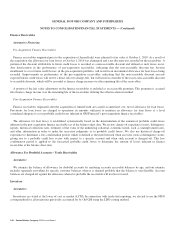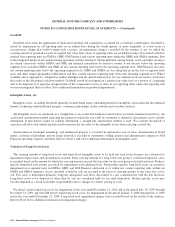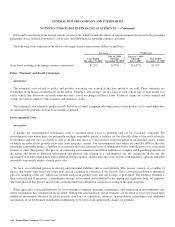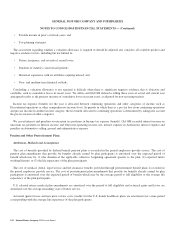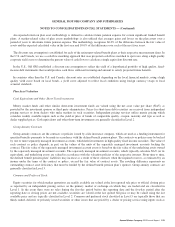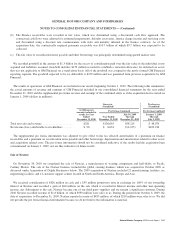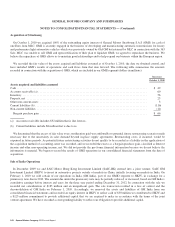General Motors 2010 Annual Report Download - page 157
Download and view the complete annual report
Please find page 157 of the 2010 General Motors annual report below. You can navigate through the pages in the report by either clicking on the pages listed below, or by using the keyword search tool below to find specific information within the annual report.GENERAL MOTORS COMPANY AND SUBSIDIARIES
NOTES TO CONSOLIDATED FINANCIAL STATEMENTS — (Continued)
An expected return on plan asset methodology is utilized to calculate future pension expense for certain significant funded benefit
plans. A market-related value of plan assets methodology is also utilized that averages gains and losses on the plan assets over a
period of years to determine future pension expense. The methodology recognizes 60.0% of the difference between the fair value of
assets and the expected calculated value in the first year and 10.0% of that difference over each of the next four years.
The discount rate assumption is established for each of the retirement-related benefit plans at their respective measurement dates. In
the U.S. and Canada, we use a cash flow matching approach that uses projected cash flows matched to spot rates along a high quality
corporate yield curve to determine the present value of cash flows to calculate a single equivalent discount rate.
In the U.S., Old GM established a discount rate assumption to reflect the yield of a hypothetical portfolio of high quality, fixed-
income debt instruments that would produce cash flows sufficient in timing and amount to satisfy projected future benefits.
In countries other than the U.S. and Canada, discount rates are established depending on the local financial markets, using a high
quality yield curve based on local bonds, a yield curve adjusted to reflect local conditions using foreign currency swaps or local
actuarial standards.
Plan Asset Valuation
Cash Equivalents and Other Short-Term Investments
Money market funds and other similar short-term investment funds are valued using the net asset value per share (NAV) as
provided by the investment sponsor or third party administrator. Prices for short-term debt securities are received from independent
pricing services or from dealers who make markets in such securities. Independent pricing services utilize matrix pricing which
considers readily available inputs such as the yield or price of bonds of comparable quality, coupon, maturity and type as well as
dealer supplied prices. Cash equivalents and other short-term investments are generally classified in Level 2.
Group Annuity Contracts
Group annuity contracts are the contracts or policies issued by a life insurance company, which are used as a funding instrument for
specified benefits payments to be made in accordance with the defined benefit pension plans. The contracts or policies may be backed
by one or more separately managed investment accounts, which hold investments in high quality fixed income securities. The value of
each contract or policy depends, in part, on the values of the units of the separately managed investment accounts backing the
contract. The fair value of the separately managed investment account assets is based on the fair value of the underlying assets owned
by the separately managed investment accounts. The separately managed investment accounts, which typically calculate NAV (or its
equivalent), and underlying assets are valued in accordance with the valuation policies of the respective insurers. From time to time,
the defined benefit pension plans’ liabilities may increase as a result of these contracts when the required reserves, as estimated by an
insurer under the terms of the contract or policy, exceed the fair value of contract assets. The resulting difference represents an
outstanding contract asset deficiency that must be funded by the defined benefit pension plan’s sponsor. Group annuity contracts are
generally classified in Level 3.
Common and Preferred Stock
Equity securities for which market quotations are readily available are valued at the last reported sale price or official closing price
as reported by an independent pricing service on the primary market or exchange on which they are traded and are classified in
Level 1. In the event there were no sales during the five-day period before the reporting date and the five-day period after the
reporting date or closing prices are not available, securities are valued at the last quoted bid price or may be valued using the last
available price and are typically classified in Level 2. Common and preferred stock classified in Level 3 are typically those that are
thinly traded, delisted, or privately issued securities or other issues that are priced by a dealer or pricing service using inputs such as
General Motors Company 2010 Annual Report 155



